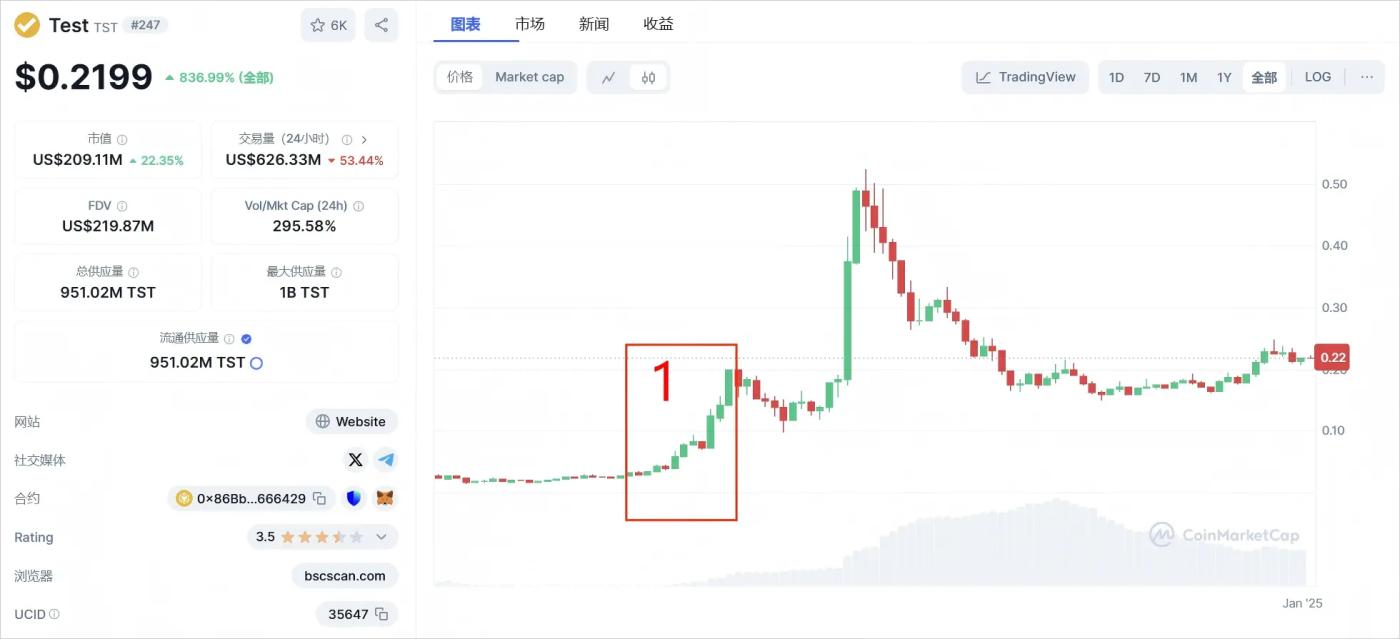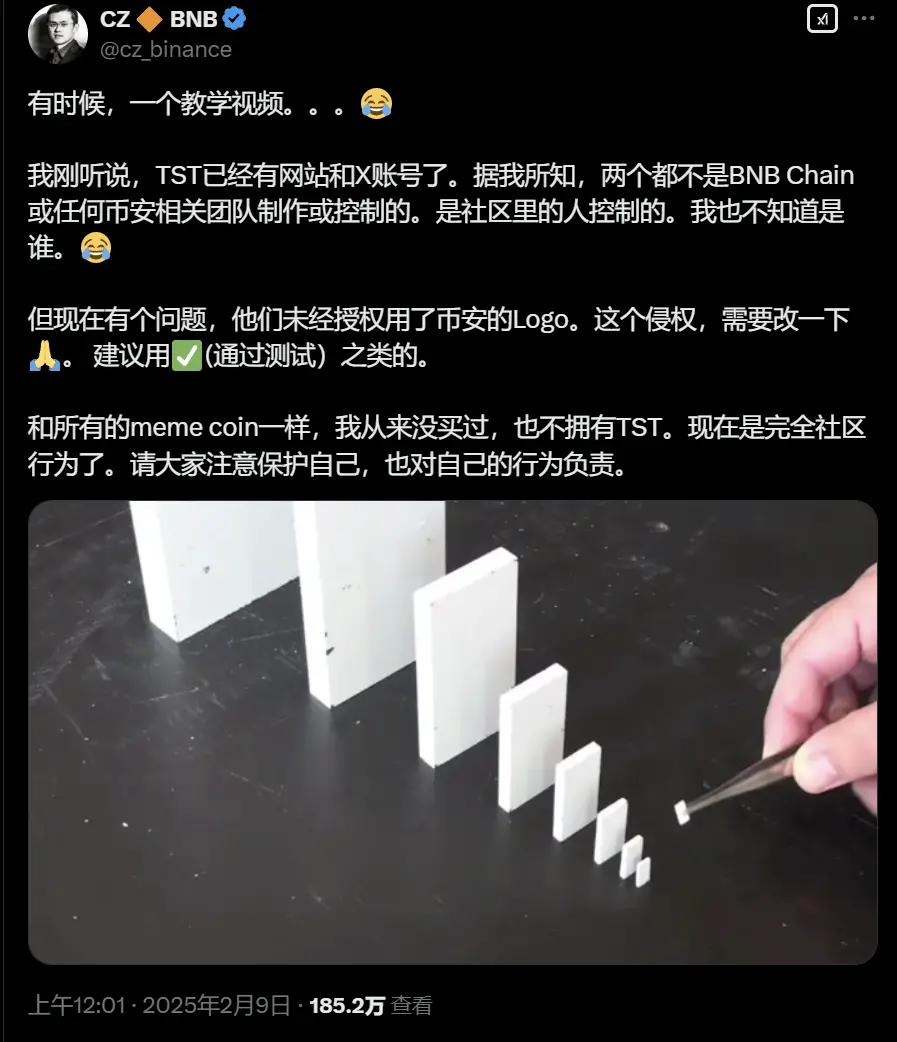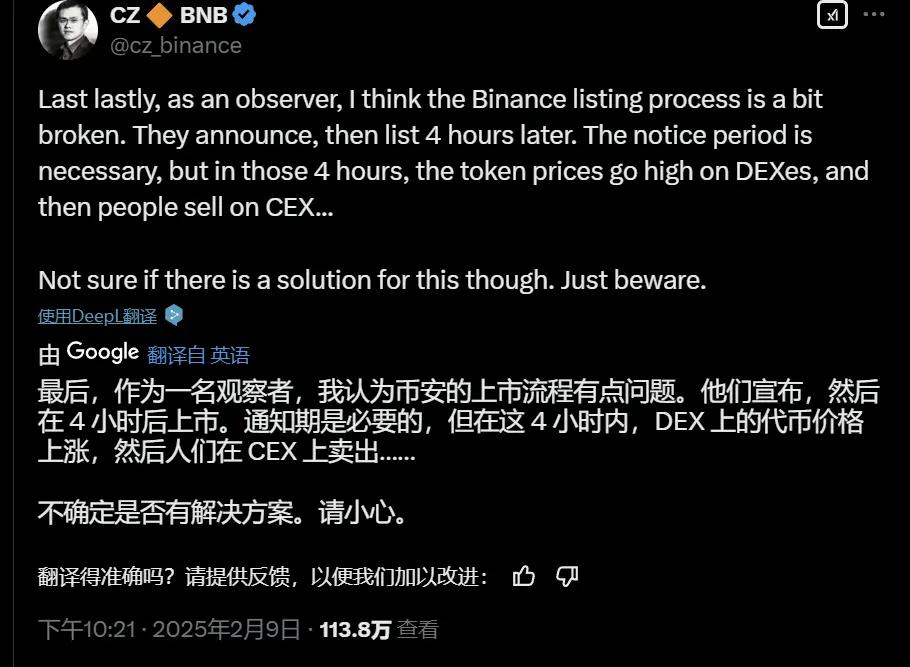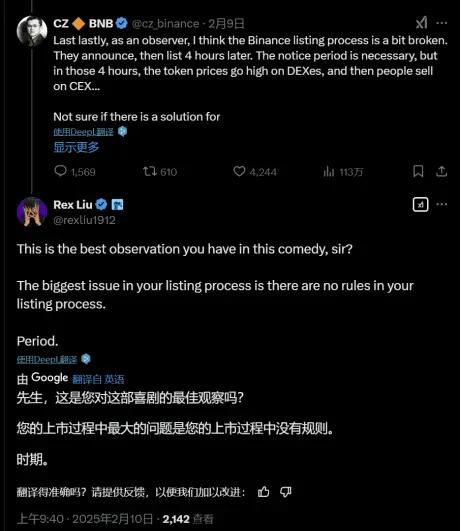Author & Editor: Scof, ChainCatcher
Recently, due to the impact of macroeconomic policies, the cryptocurrency market has generally continued to fluctuate and shown a downward trend. Accompanied by the gradual decline of the meme craze, many meme-related coins have also cooled down. However, the meme coin TST on the BNB Chain has unexpectedly experienced explosive growth, attracting widespread attention.
From obscurity to a market capitalization of hundreds of millions of dollars, the rise of TST not only caught the market by surprise, but also sparked heated discussions about Binance's coin listing logic.
This article will review the ins and outs of the TST event, and explore the market logic and controversies behind it. From the initial test token to the listing on Binance's spot trading, every step of TST's journey has been dramatic. Under Binance's "lightning-fast listing" operation, TST's market value soared from $500,000 to $500 million, an increase of over 100 times. However, the subsequent crash has caused heavy losses for many investors, triggering questions about Binance's coin listing process.
Next, we will analyze the birth, explosion, and controversies of TST one by one.
$TST Takes the Stage
According to the introduction on the TST official website, $TST is a test token deployed by the BNB Chain on the four.meme platform.
The first public mention of $TST occurred on February 6, when CZ shared a tutorial video on Twitter on how to launch a token on four.meme. In this tweet, CZ specifically clarified that $TST is not a token issued by the BNB Chain team or any official organization, but merely a test token used in the tutorial video. The tweet also included a link to the TST and BNB trading pair on four.meme. This statement may indicate that the appearance of $TST was initially not supported by the official, but rather a purely experimental project.

Phase 1: Trial Pump
On February 7, $TST received its first relatively formal promotion and publicity. At that time, four.meme held a Space live broadcast titled "Let's Talk About $TST", although it did not attract widespread attention at the time, it paved the way for the subsequent explosion. On the same day, multiple platforms such as XT Exchange, Bingx, and Bitget Wallet successively listed $TST, almost synchronously launching it in a short period of time. In addition, CoinMarketCap and CoinGecko also updated the relevant information of the token, further enhancing its market exposure.
On February 8, Binance Alpha Projects also joined the $TST lineup, marking the official debut of the token. This series of actions brought strong market attention to $TST and kicked off the first stage of its price increase - the trial pump stage, which lasted from 3 pm on February 8 to that evening. This stage of the rally laid the foundation for the subsequent performance of $TST.

Phase 2: Sideways-Explosive Pump
On February 9, after the trial pump, the price of TST rose from $0.026 to $0.19, with a market capitalization exceeding $40 million, an increase of over 6 times, and it gradually entered a sideways adjustment phase.
Just as the market sentiment fell into a trough, and many retail investors began to doubt the future of TST, even appearing FUD, an unexpected turning point occurred - Binance founder CZ posted a statement about TST on Twitter. Although the main content of this tweet was to clarify that he "never owned TST", this move unexpectedly triggered a strong market reaction.
CZ's tweet not only did not cause the price of TST to fall, but instead acted like a stimulant, quickly igniting the market's enthusiasm. Investors seemed to read more signals from this tweet: CZ's attention and statement, to some extent, brought additional exposure and trust endorsement to TST. Although he clearly stated that he did not hold TST, the market interpreted it as a potential recognition or attention. This sentiment quickly spread, pushing TST's price to rise against the trend, with its market value even surpassing $100 million in a short period of time.

But the story didn't end there. In the early morning of February 9, @Binance officially announced that TST would be listed on Binance's spot trading pairs, including TST/USDT and TST/USDC. This news immediately ignited the market's enthusiasm, and TST's market value soared from $500,000 to $500 million in just a few days, an increase of over 100 times. This rapid listing frenzy inevitably reminds people of the previous Trump coin, which also quickly landed on mainstream exchanges relying on high market attention and community heat. This time, the protagonist is TST.

Phase 3: Crash
"A coin before it is listed on a major exchange relies on narrative and consensus, but after it is listed, it is purely a capital game."
It was originally thought that TST, with the backing of CZ, would continue its previous trend after being listed on Binance, at least not looking too ugly. But its subsequent performance obviously did not break the recent "listed on Binance, then crash" curse, with the price quickly plummeting from the high of $0.52 to the current $0.17, a decline of more than 60%. During this period, although there were still some consolidation and rebounds, this was obviously a drop in the bucket for many high-price buyers, and many exchange users suffered heavy losses in this rapid PVP.
In this stage of the crash after being listed on Binance, CZ issued another statement, covering seven thoughts on this TST event, mentioning that he "was not involved in their listing process" at all, basically distancing himself from TST and Binance's decision-making again.

"Lightning-Fast Listing" Sparks Controversy: The Interplay Between Binance's Audit Process and Market Hype
This result also quickly triggered market doubts about Binance's coin listing strategy, especially since TST went from birth to listing in just a few days, and the community questioned Binance's audit process. Even CZ himself believes that Binance's listing process has problems, pointing out in a tweet that
"As an observer, I think Binance's listing process has some issues. The platform first releases an announcement, then lists 4 hours later. While the notice period is necessary, the token price can be pumped on DEXes during those 4 hours, then dumped on the CEX."

He Yi has repeatedly emphasized that Binance has a strict and complex listing audit process, aimed at ensuring the compliance and security of every project that goes online. However, this TST listing has surprised people - from the birth of the token to its listing on Binance's spot trading, it only took a few days. This "lightning-fast" listing operation inevitably makes some community members question: Is Binance really conducting a thorough audit of each project as it claims? Or is it that TST has been given a kind of "fast track" privilege to support the development of the BNB Chain ecosystem?

Some voices in the community believe that Binance's rapid listing of coins may be to leverage the hype of TST to boost the activity of the BNB Chain ecosystem. After all, the explosive growth of TST has drawn more attention to the technical capabilities and community vitality of the BNB Chain. However, whether this "fast track" will affect the fairness and rigor of Binance's listing process has also become a focus of discussion.

Nevertheless, the hype of TST has not completely subsided. Binance has added a "seed label" to it, meaning that users need to pass a risk assessment and accept the terms of use before trading, further highlighting its high-risk nature. CZ's recent discussion on the listing process has also made people wonder, should CEXs automatically list tokens like DEXs to keep up with the rapid changes in the market?
However, this incident has undoubtedly cast a shadow of controversy over Binance's listing process, and has also made more people start to think: in the rapidly developing cryptocurrency industry, how should the review process balance efficiency and security?
The story of TST, from the initial test token to the surge in market value to $500 million, and then the collapse after being listed on Binance, has almost condensed all the characteristics of the cryptocurrency market: emotion-driven, community power, exchange gaming, and market uncertainty. Its rise and fall is not only a controversial attempt of Binance's listing strategy, but also a microcosm of the entire cryptocurrency market ecosystem.






